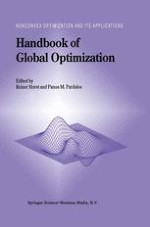1995 | OriginalPaper | Buchkapitel
Concave Minimization: Theory, Applications and Algorithms
verfasst von : Harold P. Benson
Erschienen in: Handbook of Global Optimization
Verlag: Springer US
Enthalten in: Professional Book Archive
Aktivieren Sie unsere intelligente Suche, um passende Fachinhalte oder Patente zu finden.
Wählen Sie Textabschnitte aus um mit Künstlicher Intelligenz passenden Patente zu finden. powered by
Markieren Sie Textabschnitte, um KI-gestützt weitere passende Inhalte zu finden. powered by
The purpose of this chapter is to present the essential elements of the theory, applications, and solution algorithms of concave minimization. Concave minimization problems seek to globally minimize real-valued concave functions over closed convex sets. As in other global optimization problems, in concave minimization problems there generally exist many local optima which are not global. Concave minimization problems are NP-hard. Even seemingly-simple cases can possess an exponential number of local minima. However, in spite of these difficulties, concave minimization problems are more tractable than general global optimization problems. This is because concave functions and minimizations display some special mathematical properties. Concave minimization problems also have a surprisingly-diverse range of direct and indirect applications. The special mathematical properties and diverse range of applications of concave minimization have motivated the construction of a rich and varied set of approaches for their solution. Three fundamental classes of solution approaches can be distinguished. These are the enumerative, successive approximation, and successive partitioning (branch and bound) approaches. After giving a brief introduction, the chapter describes and discusses some of the most important special mathematical properties of concave functions and of concave minimization problems. Following this, it describes several of the most important categories of direct and indirect applications of concave minimization. The chapter then describes each of the three fundamental solution approaches for concave minimization. For each approach, the essential elements are explained in a unified framework. Following this, for each approach, most of the well-known individual concave minimization algorithms that use the approach are explained and compared. The scope of the presentation of the solution approaches and algorithms is limited to those that use deterministic (rather than stochastic) methods. The chapter concludes with some suggested topics for further research.
